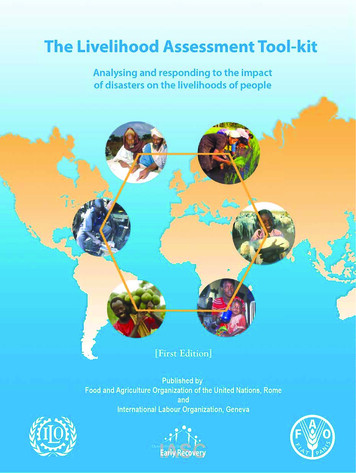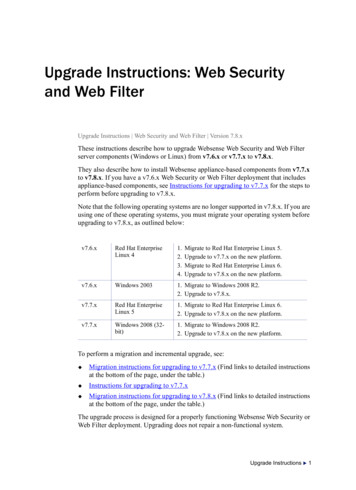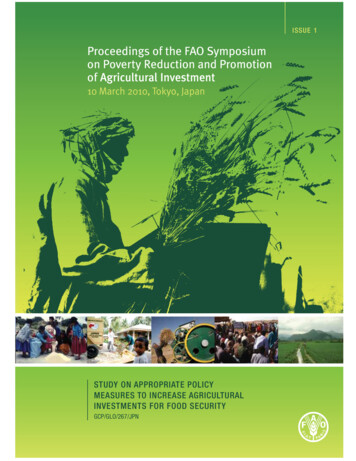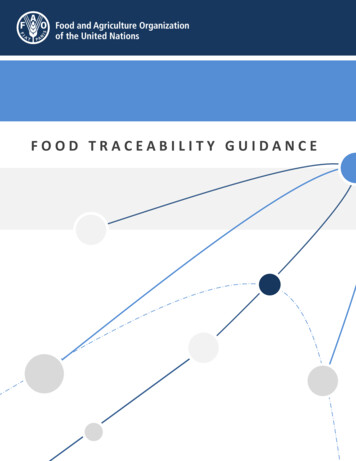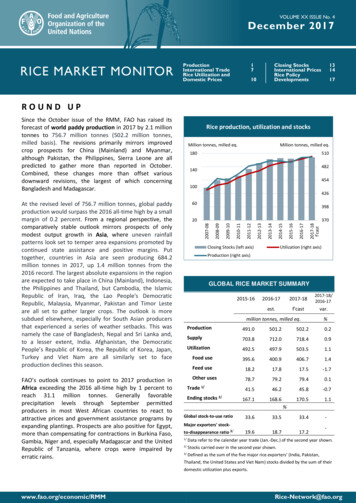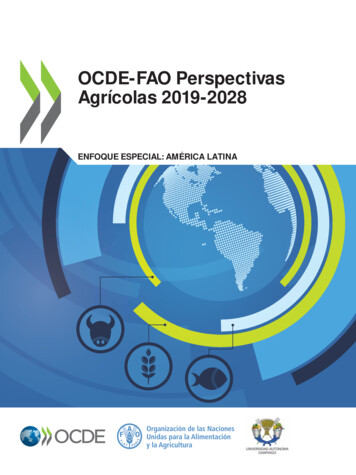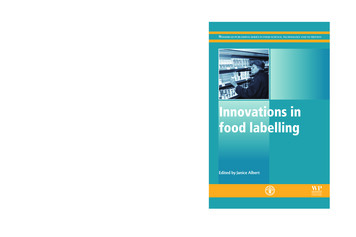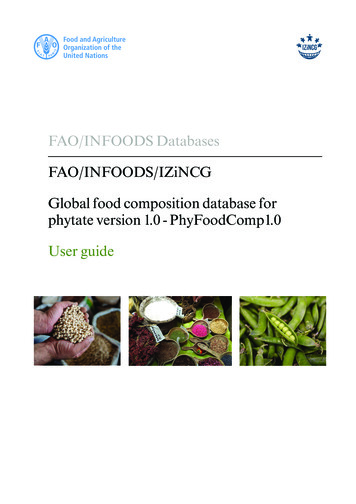
Transcription
FAO/INFOODS DatabasesFAO/INFOODS/IZiNCGGlobal food composition database forphytate version 1.0 - PhyFoodComp1.0User guide
FAO/INFOODS/IZiNCGGlobal food composition database forphytate version 1.0 - PhyFoodComp1.0User guidePrepared by: Sergio Dahdouh, Fernanda Grande, Sarah Nájera Espinosa, Morgane Fialon,Anna Vincent, Rosalind Gibson, Janet King, Doris Rittenschober & U. Ruth Charrondiere.Published bythe Food and Agriculture Organization of the United NationsandInternational Zinc Nutrition Consultative GroupRome, 2018
Citation: FAO/IZiNCG, 2018. FAO/INFOODS/IZiNCG Global Food Composition Database for Phytate Version1.0 - PhyFoodComp 1.0. Rome, Italy.The designations employed and the presentation of material in this information product do not imply theexpression of any opinion whatsoever on the part of the Food and Agriculture Organization of the UnitedNations (FAO) or Children’s Hospital & Research Center at Oakland (CHRCO) concerning the legal or developmentstatus of any country, territory, city or area or of its authorities, or concerning the delimitation of its frontiers orboundaries. The mention of specific companies or products of manufacturers, whether or not these have beenpatented, does not imply that these have been endorsed or recommended by FAO or CHRCO in preference toothers of a similar nature that are not mentioned. The views expressed in this information product are those ofthe author(s) and do not necessarily reflect the views or policies of FAO or CHRCO.ISBN 978-92-5-130306-1 (FAO) FAO and Children’s Hospital & Research Center at Oakland, 2018FAO AND CHRCO encourage the use, reproduction and dissemination of material in this information product.Except where otherwise indicated, material may be copied, downloaded and printed for private study,research and teaching purposes, or for use in non-commercial products or services, provided that appropriateacknowledgement of FAO and CHRCO as the source and copyright holders is given and that FAO/CHRCO’sendorsement of users’ views, products or services is not implied in any way.All requests for translation and adaptation rights, and for resale and other commercial use rights should bemade via www.fao.org/contact-us/licence-request or addressed to copyright@fao.org.FAO information products are available on the FAO website (www.fao.org/publications) and can be purchasedthrough publications-sales@fao.orgCover pictures: FAO/Ruth Charrondière / FAO/Nozim Kalandarov / FAO/James Hill.
.viiINTRODUCTION.1Background. 1Objectives. 2Phytate structure and influence on mineral bioavailability. 3FAO/INFOODS/IZiNCG Global food composition database for phytate 1.0 (PhyFoodComp1.0).5Data sources and principles of data compilation. 5Foods, food groups and coding. 6Components, their definitions and expressions. 81. Phytate. 82. Analytical methods for detecting phytate and separating the inositol phosphate forms. 103. Phytate:mineral molar ratios. 11Arrangement of the Excel database and worksheets. 13Documentation and quality of data. 15FUTURE STEPS.16REFERENCES.17ANNEX 1. FoodEx2 coding system.20iii
TABLES, FIGURES AND EQUATIONSTABLESTable 1. Food groups/subgroups and numbers in the PhyFoodComp.6Table 2. Tagnames, description and units considered in the PhyFoodComp.9Table 3. Worksheets in the PhyFoodComp.13Table 4. Variables capturing general information of a food entry in the PhyFoodComp.14FIGURESFigure 1. IP6 structure and mineral binding capacity.3EQUATIONSEquation 1. PHYT:ZN formula.11Equation 2. PHYT:FE formula.11Equation 3. PHYT:ZN formula.11Equation 4. PHYT:FE formula.11iv
FOREWORDMicronutrients (vitamins and minerals), though required only in small quantities, are essential building blocksfor healthy bones, brains and bodies. Such nutrients need to be obtained from food, ideally from a balancedand varied diet. However, in many parts of the world, diets are found to contain either insufficient amounts ofmicronutrients and/or antinutrients hindering their absorption. Iron and zinc represent some of the common formsof micronutrient deficiencies in terms of global public health, posing a threat to the health and development ofthe world’s populations, especially for children and pregnant women who reside in low-income countries. Inresource-poor households, the consumption of animal-based foods is usually low thereby leaving plant-baseddiets as the main source of energy and nutrients. Iron and zinc are however known to have low bioavailability inthese diets, partly due to the presence of antinutrients that bind minerals in the human gut and consequently,hinder their absorption.One of such antinutrients is phytate, a stored form of phosphorus which is mostly found in unrefined cereals,seeds and pulses. Once these foods are processed, their phytate content can decrease significantly, however, theextent of reduction that occurs in each processed food is not usually known. Data on the phytate content offoods are rarely ever included in national or regional food composition tables or databases (FCTs/FCDBs) (eventhough much data has been generated over time in this regard). Reliable compositional data regarding thephytate content of raw and processed foods are essential, but usually unavailable, for establishing meaningfulrecommended nutrient intakes (RNI), for formulating diets or products that minimize the mineral-binding effectof phytate, or for developing efficient programs and policies which lead to significant decreases in malnutrition.In order to close this knowledge gap, efforts have been combined to develop a phytate database known asthe FAO/INFOODS/IZiNCG Global Food Composition Database for Phytate. The database contains phytatedata (in its different forms and determined by different chemical methods), as well as iron, zinc, calcium,water, and different phytate:mineral molar ratios. The database will not only constitute an important tool forpolicy makers in nutrition and agriculture, but it will also assist the efforts of nutritionists seeking to designprograms aimed at eliminating micronutrient deficiencies using food-based approaches. It will provide anopportunity to revise the RNI that takes into account the negative effects of dietary phytate on mineralnutrition. As a result, the database will contribute to the reduction of mineral deficiencies and will raiseawareness on food-based approaches for increasing the bioavailability of these essential minerals in foods.Anna LarteyDirector, Nutrition and Food Systems DivisionFood and Agriculture Organization of the United NationsRome, Italyv
ACKNOWLEDGEMENTSThe authors would like to thank Paul Hulshof and Claudia Lazarte for sharing their extensive knowledge onphytate, as well as compositional data that were incorporated into the database.The authors gratefully acknowledge the support given by the colleagues from the FAO’s NutritionAssessment Team, Nutrition and Food Systems Division, especially to the developers of the FAO/WHOGlobal Individual Food consumption data Tool (GIFT) platform Catherine Leclercq, Agnieszka Balcerzakand Pauline Allemand for sharing their food group classification system and assisting in identifying andclassifying the different food entries.Our special thanks go to the European Food Safety Authority (EFSA), especially to Francesco Vernazza,Senior Scientific Officer, who gave the FoodEx2 training at FAO in June 2017. This course has been essentialfor learning about coding food composition data using FoodEx2, the food classification and descriptionsystem developed by EFSA. FoodEx2 facilitates food matching and linking of different datasets, e.g. datafrom food composition to those of food consumption.We would also like to thank Dr Karl Bailey, PhD chemist in the Department of Nutrition at the Universityof Otago, who with his extensive knowledge on phytate analysis assisted us in the description andunderstanding of the detection methods of phytate and the phytate:mineral molar ratio calculation.Our gratitude also goes to Anna Lartey, Guenter Hemrich, Maria Xipsiti, Giorgia Paratore, Diana Carter andAbisola Babalola (Nutrition and Food Systems Division, FAO) for reviewing this User Guide and providingnew inputs, suggestions and comments.This work would not have been possible without the financial support of the International Zinc NutritionConsultative Group (IZiNCG), the Canigó’s scholarship program led by la Generalitat de Catalunya, the FAOregular budget and the International Year of Pulses.vi
PAEINFOODSIP3IP4IP4 A IP5 A IP6IP5IP5 A I:ZNPPPPPPDPPIRNI/RDIWHOXPDry WeightEuropean Food Safety AuthorityPer 100 g edible portion on fresh weight basisFood and Agriculture Organization of the United NationsFood Composition Table/Food Composition DatabaseEFSA’s Food classification and description system for exposure assessment, version 2High-Performance Liquid ChromatographyFresh WeightFAO/WHO Global Individual Food Consumption Data ToolHigh-Performance Anion-ExchangeInternational Network of Food Data SystemsInositol TriphosphateInositol TetraphosphateInositol Tetra Penta HexaphosphateInositol PentaphosphateInositol Penta HexaphosphateInositol HexaphosphateTotal Inositol Phosphates (SUM of all IP forms)International Zinc Nutrition Consultative GroupLimit of DetectionNumber of independent analytical samplesPhytic acid (by HPLC/HPAE) : Iron ratioPhytic acid (by HPLC/HPAE) : Zinc ratioFAO/INFOODS/IZiNCG Global Food Composition Database for PhytatePhytic acid, unknown or variable methodPhytic acid (by unknown method) : Iron ratioPhytic acid (by unknown method) : Zinc ratioPhytic acid (global, old tagname)Phytic acid, determined by colorimetry (unknown)Phytic acid (by unknown colorimetry) : Iron ratioPhytic acid (by unknown colorimetry) : Zinc ratioPhytic acid, determined by colorimetry after an alkaline phosphatase hydrolyzationPhytic acid (by K-PHYT kit) : Iron ratioPhytic acid (by K-PHYT kit) : Zinc ratioPhytic acid, determined by anion exchangePhytic acid (by anion exchange) : Iron ratioPhytic acid (by anion exchange) : Zinc ratioPhytic acid, determined by direct precipitationPhytic acid (by direct precipitation) : Iron ratioPhytic acid (by direct precipitation) : Zinc ratioPhytic acid, determined by indirect precipitationPhytic acid (by indirect precipitation) : Iron ratioPhytic acid (by indirect precipitation) : Zinc ratioPhytate phosphorusPhytate phosphorus, determined by colorimetry (unknown)Phytate phosphorus, determined by direct precipitationPhytate phosphorus, determined by indirect precipitationRecommended Nutrient Intake/ Recommended Dietary IntakeWorld Health OrganizationConversion factor for phytate phosphorusvii
INTRODUCTIONBackgroundThere are approximately 2 billion people in the world who suffer from micronutrient deficiencies (GlobalNutrition Report, 2016). An estimated 17.3% of the world’s population is at risk of inadequate zinc intake(Wessells et al., 2012) while almost the 30% are anaemic, many due to iron deficiency (WHO, 2013). Thus,both zinc and iron deficiencies constitute a significant public health problem.Phytate is the storage form of phosphorus in plants and is found in high concentrations in seeds, cereals andpulses to allow the future germ to sprout adequately using its own nutrients – including the stored phosphorus.Since humans are unable to digest or fractionate phytate in the gut, and owing to its high mineral bindingcapacity, phytate is often classified as an antinutrient. Phytate is one of the important elements to be consideredwhen determining the bioavailability of zinc and iron from different diets and the required dietary intake levels.For example, the recommended nutrient intakes (RNIs) for zinc and iron are about 3-times higher for diets witha low bioavailability compared to those with a high bioavailability for all age groups (FAO/WHO, 2004). Thesehigh RNIs for iron and zinc make it very difficult for individuals consuming plant-based diets to achieve their RNIsthrough foods alone. The low bioavailability of the minerals bound to the phytic acid can lead to deficienciesin human populations where staples like wheat, rice and maize are the main source of nutrition (Bohn et al.,2008). Therefore, fortification is becoming the norm, especially in developed countries, in order to achieve therecommended intakes for zinc and iron.Most of the phytate data available at the time of the FAO/WHO expert consultation on vitamin and mineralrequirements (1998) were on total phytate content in raw foods (FAO/WHO, 2001). Since then however,it has been shown that some processing methods (fermenting, boiling, roasting, etc) can reduce thephytate content of foods. There have been very few cases where phytate data have been included in foodcomposition tables (FCTs) and, in most of such cases, the values included only represent the content for rawproducts, with no details of analytical methods used to generate the phytate values.FAO/INFOODS staff, therefore, decided to compile phytate data from the literature for raw and processedfoods. These data will assist in re-evaluating certain assumptions concerning phytate and improve the basisfor zinc and iron RNIs. The IZiNCG joined this process at a later stage and contributed expertise and fundingreceived through a Bill and Melinda Gates Foundation project.1
ObjectivesThe FAO/INFOODS/IZiNCG Global Food Composition Database for Phytate (PhyFoodComp) has severalobjectives:For food composition and data compilers: To provide, at a global level, phytate data together with selected mineral data (iron, zinc andcalcium), water, and different phytate:mineral molar ratios. To report these compositional data according to international quality standards with a comprehensivedocumentation following FAO/INFOODS standards and guidelines. To illustrate the differences in phytate values when using different analytical methods to determineeither total phytate or the individual inositol phosphate forms. To provide a basis for recommending the most appropriate analytical methods for determining totalphytate and the individual inositol phosphate forms. To allow compilers to include relevant phytate values into their national or regional food compositiontables or databases (FCTs/FCDBs). To provide the necessary data for generating phytate retention factors from plant-based foodssubjected to preparation and processing practices known to reduce their phytate content. To identify knowledge gaps in terms of missing compositional data.For policies and programmes: To demonstrate the variability in phytate composition in raw foods due to geography, seasonand biodiversity by incorporating cultivars, varieties, and underutilized foods. This might assistagricultural programmes and policies to select and improve those cultivars and varieties with a lowphytate content coupled with positive agricultural characteristics. To build an evidence-base for providing advice on processing methods, either at household orindustrial level, in order to lower the phytate content and/or its mineral binding capacity, andtherefore lead to an increase in mineral bioavailability. To enable governments and nutritionists to revise their advice on processing of legumes, seeds andcereals in order to increase the bioavailability of iron and zinc. To provide the basis for advice regarding improvements in infant and young child feeding, dietformulations, or product developments. To design and implement better nutrition projects, programmes, interventions and policies aimedat reducing mineral deficiencies such as iron and zinc. To increase the quality and precision of recommended nutrient intakes. To raise awareness of food-based methods that increase the bioavailability of iron and zinc.2
Phytate structure and influence on mineral bioavailabilityMyo-inositol phosphates are saturated cyclic acids found in many plant tissues, being most abundantin pulses, cereals and oleaginous seeds. They are considered the main storage form of phosphorus inplants (Mullaney et al., 2007; Frank et al., 2013). These products contribute greatly to human nutritionby representing about 40% or 60% of the total energy intake in the diets of developed or developingcountries, respectively (Gupta et al., 2015).Phytate refers to phytic acid (myo-inositol hexaphosphate), made up of an inositol ring with six phosphateester groups, and it’s associated salts: magnesium, calcium, or potassium phytate (Gibson et al., 2010).The antinutritional effect of phytate in the human diet is caused by the inability of the human digestionsystem to degrade it because of the absence of the intestinal phytase enzyme in humans. The phosphategroups in phytate are double charged and they strongly bind cations, mainly Fe, Zn and Ca, and impedetheir absorption (Hlynka 1964 ; Gupta et al., 2015). The cation binding capacity is a function of the numberof phosphate groups on the inositol ring (Figure 1) and their cis and trans positions. There are six inositolphosphate forms, each of which is named according tothe number of phosphate groups attached to the inositolring, i.e. IP1 to IP6. In mature unprocessed cereals,legumes and oleaginous seeds which have not beenstored, myoinositol phosphates are almost exclusively inthe inositol hexaphosphate (IP6) form, making it is themost abundant inositol phosphate and the strongest interms of mineral binding capacity. In general it appearsthat at least five of the six sites on the inositol ring mustbe phosphorylated for the inositol to form a strongassociation with mineral ions (Sandberg et al., 1999). Theinhibitory effect of phytate on zinc and iron absorption isdose-dependent. In the case of iron the inhibitory effectFigure 1. IP6 structure and mineralbinding capacityoccurs at very low phytate concentrations (i.e., 2-10 mg/meal) (Hurrell, 2003).Available evidence indicates that phytate in pulses, cereals and other products can be reduced by simpleprocessing methods such as soaking, germination and fermentation, thereby enhancing bioavailability ofzinc and iron to some degree. However, the extent of the reduction depends on the plant species, foodmatrix, pH, humidity, length and conditions of the processing method; minimal reductions are achievedafter soaking whole seeds or legumes. Phytate is relatively heat stable during normal household boilingtemperatures of 100ºC, but in industrial processing such as canning or extrusion cooking when highertemperature are used there will be some loss (Schlemmer et al., 2009). Mechanical processing such as3
milling unrefined cereals and dehulling legumes can also lead to significant reductions in phytate, as wellas minerals. Because the negative effects of phytate on zinc and iron absorption are dose dependent, molarratios of phytate to zinc and phytate to iron minerals have been calculated to estimate the likely proportionof dietary zinc, and to a lesser extent iron, absorbed.
FAO/INFOODS/IZINCG – GLOBAL FOOD COMPOSITIONDATABASE FOR PHYTATE 1.0 (PHYFOODCOMP1.0)The FAO/INFOODS/IZiNCG Global Food Composition Database for Phytate (PhyFoodComp) is the firstglobal repository containing analytical data on the phytate content of foods. PhyFoodComp represents theequivalent of an archival database, which means that no nutrient or antinutrient values were calculatedor estimated to complete the compositional profile of a food entry. The database holds data of differentedible parts of the same food; different processing stages (from raw to ultra-processed); different stagesof maturity, growing and field conditions and storage; and also homemade and industrial complex recipes(composite foods).The database can be downloaded in excel format together with its documentation (the present User Guide)free-of-charge from the INFOODS page (http://www.fao.org/infoods/infoods/en/) or from the IZiNCGwebsite (http://www.izincg.org/).Data sources and principles of data compilationIn 2016, FAO/INFOODS carried out a detailed literature search on the phytate content of different foods. Datasources included scientific papers, theses, university reports, FCT/FCDB and data received from the INFOODSnetwork. The papers were mainly obtained from an exhaustive scopus search, where the information andthe abstracts of each article were examined to determine the presence of useful data. Analytical data fromfive FCTs/FCDBs (National Food Composition Tables and The Planning of Satisfactory Diets in Kenya, 1993;Indian Food Composition Tables, 2017; Food Composition Table for use in The Gambia, 2011; FAO/INFOODSFood Composition Database for Biodiversity, 2017; FAO/INFOODS Analytical Food Composition Database,2017) were obtained. From the 6020 articles found in the scopus search, 1859 contained employable data,of which 251 articles could be compiled in the database.The data were evaluated and compiled according to international standards for food composition and theINFOODS food component identifiers (Klensin et al., 1989), the Compilation Tool (FAO/INFOODS, 2012) andthe compilation process as outlined by Greenfield and Southgate (2003). The Guidelines for Checking FoodComposition Data prior to Publication of a User Database (FAO/INFOODS, 2012) were used as a tool for thefinal checks of the data.5
Foods, food groups and codingPhyFoodComp contains 3,377 food entries and recipes which were categorized into 19 food groups andtheir subgroups (see Table 1). These food groups and subgroups were adapted from the ‘Food groups forsimple indicators’ classification system developed by FAO for the GIFT platform (FAO/WHO, 2017), which isbased on the FoodEx2 food classification and description system (EFSA, 2015).Each food entry was assigned a unique food code (food item ID), which was constructed using the sameprinciple throughout all food groups. The first four figures indicate the food group and subgroup followedby four sequential figures representing the food number within the respective food group. In addition,every food was coded using FoodEx2 (see Annex 1) which was useful for harmonization, for fosteringfood linkage across domains and for providing the possibility of semi-automated food matching thereby,making the process quicker, more robust and consistent for attaining a high quality of data linking andmatching. An exact match between the PhyFoodComp foods and FoodEx2 was possible in 35% of the foodentries (indicated as ‘Yes’ in the column called ‘Exact match’). Non-exact food matches were marked by‘No’ and an explanation on the missing facet/species is provided in the column ‘Matching comments’ of thePhyFoodComp (Table 4).Table 1. Food groups/subgroups and numbers in the PhyFoodCompCode offood groupName of food groups and subgroupsN.of foods01Cereals and their products01 Rice and rice-based products02 Maize and maize-based products03 Wheat and wheat-based products04 Sorghum and sorghum-based products05 Millet and millet-based products06 Other cereals, mixed cereals or unidentified cereals and their products02Roots, tubers, plantains and their products01 Potato, sweet potato and their products02 Cassava, similar roots (excluding taro) and their products03 Taro and taro-based products04 Yam and yam-based products05 Other starchy roots and tubers (excluding sugary roots and tubers) and their products06 Plantain and plantain-based products16854331521311403Legumes and their products01 Pulses (excluding soybeans) and their products02 Soybean and soy-based products92372919404Vegetables and their products01 Leafy vegetables: fresh02 Yellow and orange vegetables: fresh03 Vegetables (excluding leafy and including fresh legumes): fresh04 Vegetables - all types: dried37823491033305Fruits and their products01 Yellow and orange fruits: fresh02 Fruits: fresh03 Fruits: dried04 Fruits: processed (excluding dried and candied)13946827461,18034614823774141233
0607Seeds, nuts and their productsMeat01 Offal - all types: fresh and processed (excluding dried)02 Mammals, reptiles and amphibians (excluding offal): fresh and processed (excluding dried)03 Birds (excluding offal): fresh and processed (excluding dried)04 Meat - mixed or unspecified: fresh and processed (excluding dried)05 Meat - all types: dried08Insects and grubs509Eggs: fresh and processed010Fish and shellfish01 Freshwater fish (excluding offal): fresh and processed (excluding dried)02 Diadromous fish (excluding offal): fresh and processed (excluding dried)03 Marine fish (excluding offal): fresh and processed (excluding dried)04 Offal - fish and shellfish: fresh and processed (excluding dried)05 Shellfish (excluding offal) - all types: fresh and processed (excluding dried)06 Fish and shellfish - mixed or unspecified: fresh and processed (excluding dried)07 Fish and shellfish (including offal) - all types: dried6111000311Milk and milk products01 Milk: fresh and processed (excluding fermented, cream, whey, cheese and other milk products)02 Fermented milk products03 Cream, whey and any other milk products excluding fermented milk products and cheese04 Cheese2200012Fats and oils01 Vegetable fat and oil (excluding red palm oil)02 Red palm oil03 Animal fat and oil431013Beverages01 Alcoholic drinks02 Drinking water03 Tea, herbal tea, coffee and cocoa04 Clear broths05 Soft drinks06 Fruit and vegetable drinks07 100% fruit and vegetable juices240121010114Sweets and sugars01 Dough-based sweets02 Chocolate-based sweets03 Fruit and nut-based sweets04 Other sweets05 Sugars43291120215Spices, herbs and condiments01 Herbs and spices02 Condiments114843016Foods for particular nutritional uses01 Infant formulas and ready-to-eat meals for infants and young children02 Foods for weight reduction03 Foods for sporting people04 Foods for medical purposes05 Food supplements and similarFood supplements and similar111107004091718Food additives01 Sweeteners and flavorings02 Colorants03 Other food additives04 Home-preparation aids05 Ingredients for food fortification/enrichment and supplements06 Microbiological or enzymatic ingredients19Complex recipes01 Industrial recipes02 Homemade / Food service recipes201101000200000266660TOTAL ENTRIES73,377
Phytate data were not available for all the food groups and subgroups; therefore, some groups/subgroupsremained empty. Data on food groups that contain no phytate (e.g. some beverages, animal-source foods,etc.) were included when available in order to emphasize the absence of phytate in these groups.In some cases, the assignment of a food to one specific food group was difficult, e.g. peanuts are botanicallylegumes but are considered as nuts in terms of their consumption and nutrient profile. This should be takeninto consideration when searching for a food, as the assignment to a single food group might not beunequivocal.It is also recognized that the identification of
foods are rarely ever included in national or regional food composition tables or databases (FCTs/FCDBs) (even though much data has been generated over time in this regard). Reliable compositional data regarding the phytate content of raw and processed foods are essent

